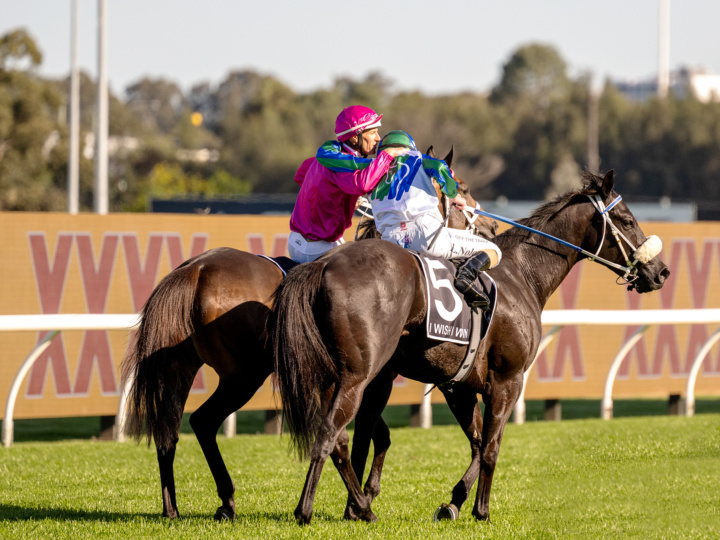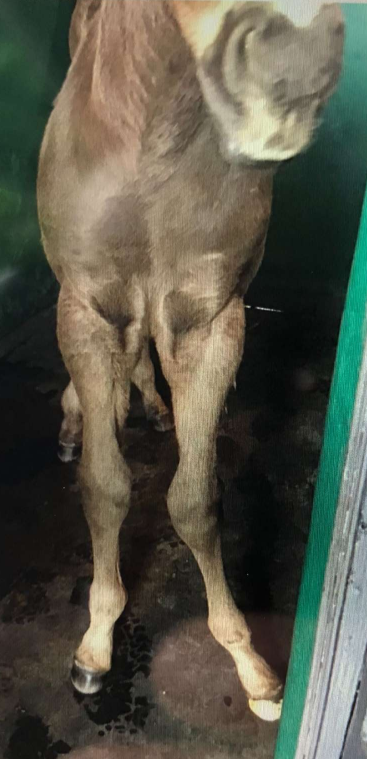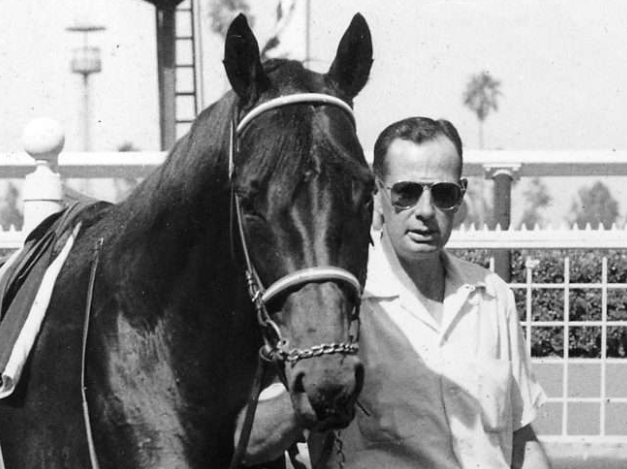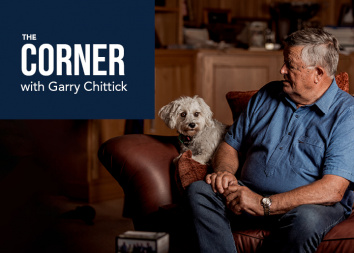Welcome back home, Wishy

From standing quietly behind the hedges so no one could see the severe front leg deformities as a foal, to shining on the world stage, I Wish I Win (ex Make A Wish) is a story of passion, patience and belief – this is his story.
It’s a dilemma that all studmasters will face sooner or later: one of your best mares produces a foal with a limb so deformed that it is commercially unviable. In everyday terms, at least one of its legs sits at an odd angle, and it will not interest buyers at a yearling sale.
I Wish I Win is by nine-time NZ Champion Sire Savabeel and out of the Pins mare Make A Wish, who also produced the stakes winner Another Dollar (Ocean Park) and hails from the family of Group 1 winner Savy Yong Blonk (Savabeel).
No longer with Waikato Stud, Make A Wish left one final gift – a filly – who has been named Last Wish.
So, the arrival of I Wish I Win with his left leg sitting at a stark angle was not what Mark Chittick had hoped for.
“From day one we were hugely disappointed to have a foal born with that leg out of one of our favourite mares. It’s one of our favourite families, she’s a beautiful mare and typically the family leaves great types,” Chittick explained to Oz Wedmore of TTR AusNZ.
“At that stage, we hadn’t sold his full brother, but we knew he was a beautiful horse, and he was going to be at the top end of whatever yearling sale he was going to go to.”
That full brother, now named No Limits, sold for $1.4 million at the 2019 New Zealand Bloodstock National Yearling Sale to David Ellis.
“And then we got this bloke; he was shocking. For the first couple of times you laid eyes on him you didn’t know whether to laugh or cry.”

So, how exactly did I Wish I Win go from this to being the poster boy for New Zealand racing?
There are many options available to studmasters faced with similar challenges — from confinement or reduced exercise (to minimise limb strain) to more involved surgical solutions. But Waikato Stud is firmly in the ‘less is more’ camp.
While many studs turn to surgery when dealing with serious angular limb deformities, Chittick prefers to keep things natural. Waikato has rarely taken a surgical path with their young horses.
That doesn’t mean the horses are left to themselves – far from it. A range of management strategies can assist with correction.
“Any foal born here at Waikato Stud has a constant and very experienced eye over them from the minute they’re born. Whether that’s myself, Garry (Chittick), Mike Rennie, Jaimee Underwood, Andrew Jackson, and our on-farm farrier Kane Clayton-Greene – between all of those people they’re thinking the same way, as natural as possible with no pressure applied,” Chittick explained.
“All of those people have over 10 years’ experience, if not 20 years’ experience of watching, nurturing and growing foals. They’ve all had experience with horses going through our system with that philosophy, and they’ve seen the results.”
The Options Available
“I’ve heard many examples of people using screws to help with their development to straighten things up, but that’s not something we do,” said Chittick.
Using a screw refers to ‘transphyseal bridging’, where a screw is inserted across the growth plate (in either the fetlock or knee), slowing growth on one side to help straighten the limb.
“We did once, and I was even against that, but our vet, Trent Jorgensen, convinced me in this case. We had a filly with a hind fetlock that was rolling out, and he said a screw may help here. So, we put a screw in there for three months and it certainly has helped her walking ability, and it looks more comfortable for the horse.”
“That’s the only time we’ve ever used a screw on a horse… but I’m not on other farms, and I’m not saying they’re wrong and we’re right.”
“I Wish I Win would have been a classic example for a screw, but we let him develop through.”
Another option some studs use is ‘periosteal stripping’, which involves agitating the periosteum over the growth plate to accelerate growth on one side. But Waikato has moved away from this approach.
“We’re constantly watching these foals but the last time we did a periosteal strip on the farm was probably 10 years ago. I’m not against them, because it’s such a minor operation at the early part of their life,” he said.
Often, periosteal stripping involves a period of confinement – and Chittick questions what part actually does the correcting.
“Quite often, when we were doing periosteal strips, we were confining foals because they’d had this little operation.”
“But what was working? Was it the confinement or the periosteal strip? Well, we haven’t done a periosteal strip for 10 years and we’re still getting the same results.”
While studs strive to present correct yearlings to maximise sales results, Chittick is clear-eyed about the true cost.
“I’m a big believer that how they’re made is how they’re made, and if you play around with things too much you risk altering a horse away from its natural gait.”
“…a lot of the things that we’re doing early on in their lives are for cosmetic reasons for yearling sales.”
He also points out that I Wish I Win was the exception, not the rule, in a family known for producing beautiful types.
“He’s the only one she’s had like that. He’s the worst conformed and the fastest so far.”
Experience has changed Waikato’s approach.
“Up until 10 years or so ago we had the blinkers on as such. We had 14 months or so to make them look the best they can look.
“But I’m a believer now that every horse has its opportunity, and for a lot of them it won’t be as a 14 or 16-month-old horse who’s going to get walked up, picked and prodded and seen for two minutes in a yearling auction ring.”
“Come the yearling sales we try not to have our horses too heavy. They’re only young horses… they’ve still got another good year or so of development ahead of them.”
A more patient, less interventionist approach can be the difference.
“I do think that with those ones that are a little bit marginal, most of the time it’s just immaturity, and if they’re pushed through a yearling sale you won’t get that opportunity to find out when their best day is.”
In I Wish I Win’s case, a yearling sale was never an option.
“I could never have tried. You could not have given that horse away!”
Some Traditional Inspiration
The cause of angular limb deformities is still not fully understood, but Chittick has his own theory – and a traditional solution.
“Quite often, I believe, they have too much natural muscle. His limbs just weren’t up to carrying the bulk. He was out of proportion, and too heavy for his joints as a young horse.”
So I Wish I Win was gelded early – something Chittick believes helped him develop.
“One thing I like doing with a horse like him, who was never going to go to a yearling sale, is gelding early.”
“There’s two schools of thought, that you let them develop as colts to get that natural muscle and then they’re gelded. Or, and it’s more of an old horseman’s view, you do it early.”
“Bob Morris (pictured) was a great breeder here in New Zealand, and he was a great believer in gelding early. He even used to geld some before the yearling sales. He believed that if they were gelded early, they developed better, with less testosterone.”
Gelded at 12 months, I Wish I Win was then left to develop at his own pace.

Bob Morris | Image credit to NZ Racing Desk
The Next Steps
Once his issues were deemed purely cosmetic, it was time for pre-race education.
“We left him a little bit later to start, and I sent him to Jamie and Chanel Beatson at Ohukia, and I said, ‘You can’t laugh at this horse’.”
The feedback was encouraging.
“‘You wouldn’t know when you’re on him,’” came the report from Jamie Beatson.
“Jamie is a fantastic horseman, and he was pretty complimentary about him. So, then it got to a stage where we had to place him with a trainer.”
Sent to Jamie Richards, I Wish I Win won his first start at Awapuni after two trials – and immediately caught attention.
“I had numerous phone calls from people to purchase him for Hong Kong,” recalled Chittick. “By all means go and have a look, but I don’t think you’ll be wanting to buy him.”
“All of them rang back and said, ‘I see what you’re talking about.’”
He became a farm favourite, and stayed in the system, racing at Group level and earning a start in the Gr.1 New Zealand Guineas. Though unplaced there, he finished his Classic year with a third in the Gr.1 Levin Classic, behind Imperatriz and On The Bubbles.
He raced nine times and showed no soundness issues.
“We certainly used to run the x-ray through his joints and there was one time when there was a little remodelling, but we just gave him the time to catch up and it hasn’t held us up at all.
“We got to the end of his three-year-old career with a sound horse who is Group 1-placed.”
The Move to Australia
A move across the Tasman beckoned – and so did bigger opportunities.
“We’re racing him for fun because we love him, and Moods (Peter Moody) came up with an idea for him to join his stable so that’s what we did.”
“He’s had one start in Australia, and it looked pretty impressive.”
“His next start is in the Sir Rupert Clarke Stakes, 1400 metres, September 17, for a million bucks!”
Instead, Moody chose to target the Listed Testa Rossa Stakes (1300m) a week later – and I Wish I Win blew them away by a length.
Four weeks on, he claimed the A$10 million Golden Eagle (1500m) at Rosehill Gardens.
It didn’t stop there.
The son of Savabeel would go on to win the Gr.1 TJ Smith Stakes and Gr.1 Kingsford–Smith Cup and run an incredible third in the 2023 The Everest.
His final appearance came with a first-up third to Mr Brightside in the Gr.1 Futurity Stakes (1400m) on 22 February 2025.
The announcement of his retirement followed the next week – closing the chapter on a remarkable career that, at one time, was hidden behind a hedge.

G2 Success For Savabeel’s Hinekaha
“I think she is a Group One horse.” Taking up the running, which is not her usual pattern, gave the connections of Savabeel’s daughter Hinekaha their biggest pay day as the 4yo was all class …
Read More
The Corner with Garry Chittick
It would seem The Corner is subject to differing interpretations, whilst, focused on my two mystery readers, I could be reasonably relaxed. It would seem The Corner is gathering a slightly larger following – I will need to be a little more sensitive to the add-ons’ views.
Read More